






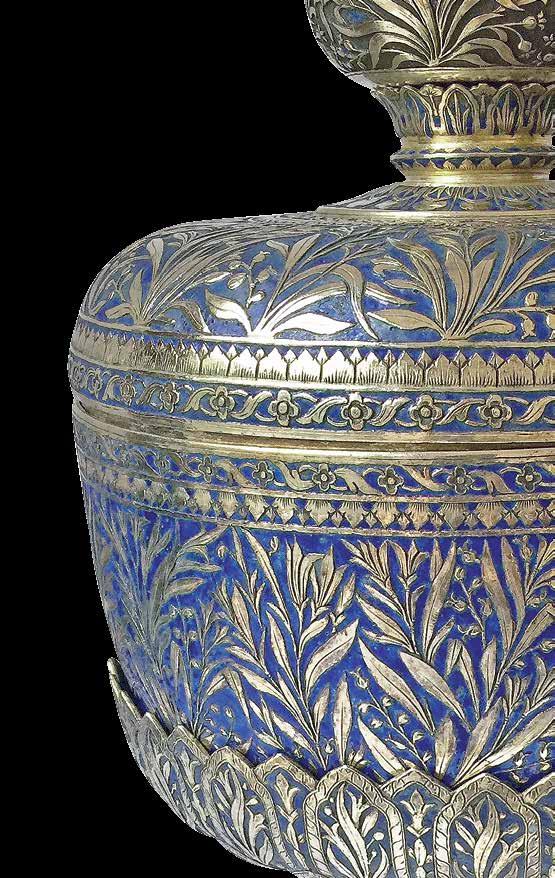
Given the surprising paucity of published materials on Thai silverware (khrueang ngoen) in English or Thai, and the fact that the industry has for many years been in decline, the subject matter of this book is now particularly relevant. As an admirer of Thai silverware for some thirty years, I have often wondered how Thai silversmiths were able to produce such beautiful and often intricate products for decorative and/or utilitarian purposes. Their skill and workmanship is of the highest level, yet often completely overlooked.
Unlike Indian, Burmese and Malay silver, each of which is more familiar to Europeans thanks to the British colonisation of those countries in the 19th century, little is generally known about Thai silverware. The main reason is that it is generally not found, or appreciated, outside of Thailand, as relatively few silver objects were exported to Europe (or elsewhere) compared to Burmese, Malay, Indian, and even Cambodian, silver wares, which are still routinely found for sale in the British and French antiques marketplace. Given their colonisation, there was greater historical trade and social interaction between Europe and these countries in the 19th century and the first half of the 20th century; and in the case of Indian and Burmese silver, at least, the Indian colonial government actively promoted Indian silver domestically, namely in the exhibitions of Calcutta (18831884), Jaipur (1883) and the Delhi Durbar (1903), in an effort “to arrest the decline of ‘traditional arts’, and to uplift the market for Indian commodities.”1
Another reason for the dearth of international interest in Thai silverware is that many silver objects made by Thai, or Thai-Chinese, artisans in Thailand are often perceived incorrectly to have been made in China: consequently, they are incorrectly categorised as Chinese Export Silver. In part, this happens because many pieces have Chinese marks on the base. However, there is also an attitude among some dealers and collectors that the best quality must have been produced in China rather than in an external (i.e. inferior) market, or as one antiques dealer quipped of this chauvinistic attitude: “If it’s good, it must have been made in China; it couldn’t possibly be local”. The same dealer confided that some dealers now also

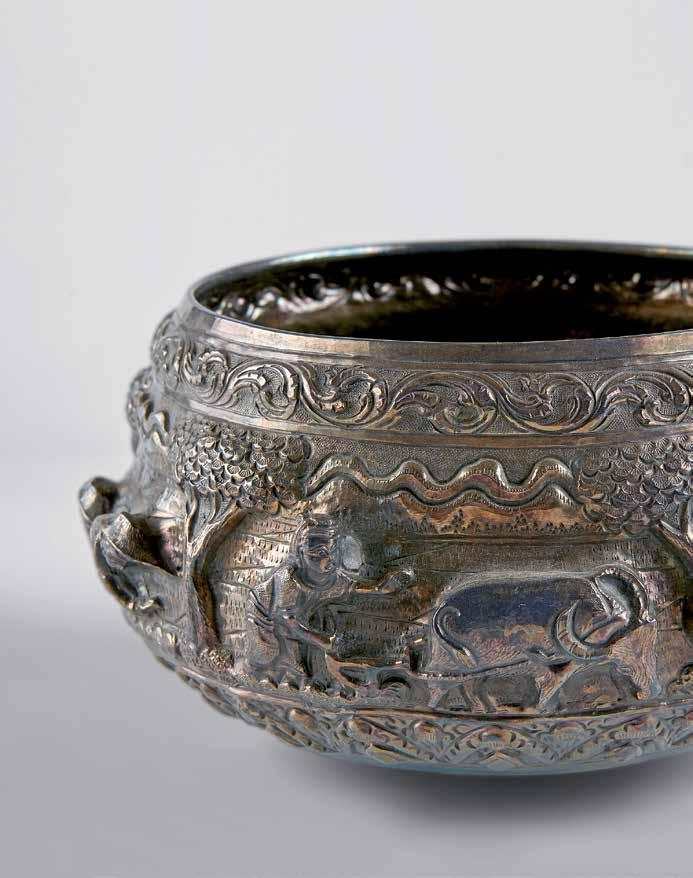
Silverhas not been discovered or mined in what constitutes present-day Thailand, although significant silver deposits have been found in neighbouring Laos, Burma (Myanmar) and Vietnam, and silver has been imported into Thailand from each of these countries. As noted in 1912 by Colonel Gerolamo Emilio Gerini (1860-1913), the influential Italian geographer, military instructor and former Director General of the Royal Military Academy (now Chulachomklao Military Academy) who was resident in Thailand for almost thirty years:
“Silver has always been one of the scarcest metals in Siam. Although present in scarce quantities in the galena1 referred to above, and in mines which are said to have once existed near Wieng Chan2 in the East Lau country and near Nan in West Laos, its supply has proved inadequate to the demand, so that it has invariably formed an article of importation.”3
Thai silversmiths also melted down imported Indian rupees, Indo-Chinese piastres and Chinese silver coins,4 or ingots, hammering them into sheets as the base material for production.
It is difficult to imagine now a time before national currencies were used for trade, but silver was literally the most common currency used in China and Southeast Asia from the late 16th to the mid-19th century; in fact, it has recently been described as the first truly global currency.5 Although statistics do not exist as to how much silver Thailand imported, it has been estimated that the Southeast Asian annual trade, at its peak in the 17th century, was worth the equivalent of 220 tonnes of silver.6 Most of this was Spanish American silver bullion – extracted from the huge silver mine at Potosí in present-day Bolivia – carried to Asia as the main commodity of the annual Manila galleon trade that has been coined a “Silver Road” (la ruta de la plata)7 because, just like the famed Central Asian Silk Road, it changed global trade immeasurably and forever. The silver was then carried from Manila to China and Southeast Asian ports by Chinese junks, Portuguese, Dutch and British trading ships.8 By the early to mid-17th century, demand for the Spanish colonial real

Global Flow of Silver, 16th-18th century
1.01 Global Flow of Silver, 16th-18th century.
(Source: “The Silver Way: China, Spanish America and the Birth of Globalisation, 1565-1815”)
(real de plata), also known as the ‘Spanish dollar’ or the ‘Mexican dollar’, became so widespread that it effectively had become the regional currency.9
Although much of the silver imported from the Americas eventually found its way to China, a significant portion passed en route through Ayutthaya and other Thai trading ports,10 as a truly global economy developed, spurred by interaction between Indians, Persians, Arabs, Armenians, Bugis, as well as Europeans and Chinese.
“As the Dutch became more practised in Asian trade, they began to traffic in goods between one Asian port and another. They brought in silver and copper from Japan. The silver they used to purchase other goods in Ayutthaya, and the copper they sold, perhaps for casting bronze Buddha images and cannon, or to be sent on to India.”11
Indeed, by the 1830s, the demand for silver served a dual purpose for the Thai court – to address the trade imbalance with China while providing the material required for the production of coinage:
“A considerable amount of bullion was also imported by the Siamese court, because Siam’s exports to China still far exceeded imports from there; the difference was made up by importing silver (back in the time of Rama II, silver ingots were already being imported by this means from China) for the purpose of melting specie. The increasing use of Chinese labor and greater demands for Western goods, including firearms, were among the important reasons necessitating a larger circulation of cash and money; the silver bullion was converted into silver lumps or “bullets” which was the main currency of the country.”12
Thailand has ever since continued to import large quantities of silver. When the regional supply of silver coins and ingots disappeared in the mid-20th century, these were gradually supplanted by silver sheets, bars and pellets, imported mainly from Australia, Germany and Switzerland.13
In the 1980s, the Thai Niello & Silver Ware Association defined “Thai silverware” as:
“silver ware in the shape of ornamental receptacles, niello ware and coloured enamelled ware manufactured in Thailand.”14
The Association mandated that Thai silver must have at least 92.5% silver but may usually contain as much as 96%, with the remainder comprising copper to allow for malleability during the shaping process. That was not always the case, and individual silversmiths used their own proprietary formulas, or ratio, during production for various alloys.
Although the production techniques of silverware in Thailand have been covered elsewhere, it is important to reexamine this dying artisanal skill for two key reasons: the two main English language publications15 are now long out of print
3.67 A selection of sixteen various silver, silver gilt and enamelled snuffboxes, each with various Chinese marks to the base, late 19th and early 20th century

Thais also smelled snuff from a distinct bottle (ya dom) that looks like a pepper shaker. Whereas the use of snuff through a tube is now an anachronism in Thailand, the use of inhalers (usually of the disposable plastic variety) remains commonplace.
The term “ya dom”, which literally means “smell medicine”, could pertain to the ingestion of snuff, but now usually refers to inhalants, often containing camphor, a variety of herbs or even peppermint, that are used to ease a blocked nose. Found in silver and niello, as well as aluminium cleverly emulating silver, inhalers rarely have maker’s marks on the bottom.
There is also a considerable range of paraphernalia in Thailand that sometimes accompany a snuff bottle. These include grooming tools, such as nail clippers, scissors, ear cleaners, etc.
Attached to a chatelaine hook, the snuff bottle and grooming kit are hooked onto a belt around the sarong. These were made mainly for the personal use of members of royalty and the nobility.
3.68 A group of five silver ya dom inhalers, each decorated in a different pattern, together with a black niello ya dom inhaler and a gilded silver niello ya dom inhaler, late 19th and early 20th century. Height from 3.8-5 cm
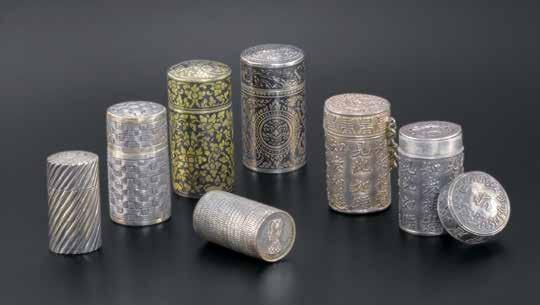

3.72 A very large spherical water-pot with bone handle and silver knob, decorated with large birds flying amidst acacia trees and foliage, with a bamboo pattern on the spout, ‘Hui Yuan’ mark, late 19th- early 20th century. H: 32.5 cm, D (base): 11.5 cm (Béatrix Dayde Latham Collection)
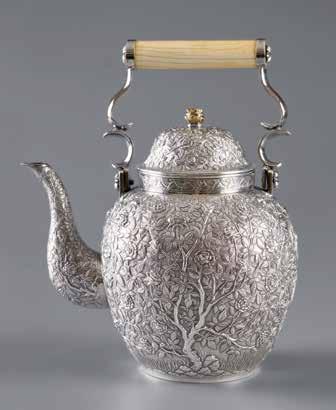

3.73 A spherical water-pot with bone handle and gilded knob, decorated all over with dense rose bushes and flowers, ‘Nan Xing’ mark, late 19th- early 20th century. H: 23 cm, D: 8 cm (Béatrix Dayde Latham Collection)
The humble tray (that) has been elevated to an art form in its own right in Thailand, to the extent that the best examples can now cost thousands of dollars. Functioning as the base for betel sets or tea sets, trays were produced in silver, niello, silver gilt and with enamelling, in many different sizes, shapes and designs, of which the most common were oblong, square, round, oval, octagonal and lobed. Patterns include Thai and Chinese designs and motifs.
3.75a Detail of the tray border design
3.74 A silver teapot warmer with handle, the body consisting of eight panels each containing elephants of war within a flame (kranok) design, late 19th century. H: 12 cm, D (mouth): 13 cm, (base): 9 cm


3.75 A “Chinese-style” tea set comprising a large lidded cup in a bowl together with four teacups, each decorated with horses on an orange ground, with the interior decorated with a floral design in blue and white, all set on a silver gilt eight-sided tray depicting various mythical and real animals, late 19th century. L: 30 cm, W: 20 cm

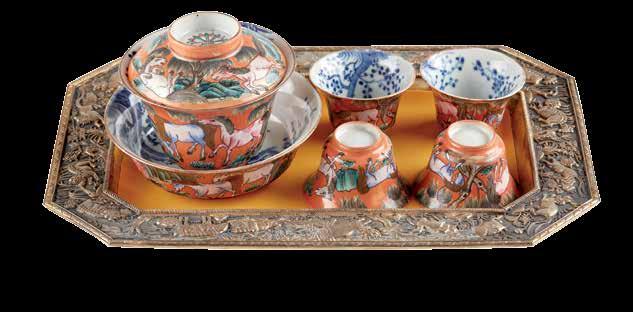
5.14 Six pear-shaped silver snuff bottles incorporating King Rama V medallions on front and back. Each is incised with royal emblems and the “Chor Bor Ror” cipher of King Rama V. Height of bottles ranges from 7-7.5 cm

5.15 Eight smaller silver snuff bottles incorporating King Rama V medallions (including one gold and one enamelled medallion) on front and back. Height of bottles ranges from 4.5-5.8 cm
Although made to stand, most incorporate an overhead loop for wearing on a belt. The stopper is technically an advance, as it is a unique combination of the cap top and the Chinese-style cork and spoon so that the neck is gripped by the stopper both from outside and inside the bottle. A curb chain is also fitted to the stopper. This would have prevented the bottle from easily spilling expensive snuff onto the floor.
It is important to point out that the authenticity of these Rama V bottles has been questioned. Some Rama V medallions have been faked and I have seen a number of obvious forgeries. However, at least a dozen different medallions were used, with

5.16 “Snuff Bottle and applicator of blue enamelled silver with the royal initials of Her Majesty Queen Saovabha with the commemorative wordings (sic) ‘Presented to Her Majesty in the year of Rattanakosin Era 109 (AD 1891)’.” L: 6.5 cm (Collection of Vivanmek Palace)

most never having been published. A few sport the name of the engraver of the series, “A. Patey” or “Aug. Patey”, standing for Henri-Auguste Patey (1855-1930), who was Chief Engraver of the Paris Mint from 1896 to 1930. The style of decoration on the bodies of the bottles varies greatly and incorporates an array of royal symbols and versions of the royal cipher consistent with other palace artefacts of the period. There is an established market for these snuff bottles although the medals are even more highly sought as amulets and royal memorabilia.
What is not in doubt is that the demand for snuff bottles made of silver, and other materials, was great during the Fifth Reign. In his memoir of serving as Physician to the Royal Court of Siam during the early 20th century, Malcolm Smith (18751958) offers the following description of Queen Saovabha Phongsri (1863-1919), the Regent Queen of King Rama V and the mother of the next two kings:
“At the end of the meal the Queen took snuff, blowing it into her nose through a small U-shaped tube as the Chinese do.”23
Smith moved to Siam in 1901 where he remained in practice until he returned to England in 1924. He interacted with the

According to legend, the historical Buddha is thought to have lived and taught in northern India (perhaps today’s southern Nepal) in the 6th century BC. While there are no contemporary images of the Buddha, he has left behind a great legacy in terms of his dharma, or sacred teachings, on which Buddhism is based, and the monks who, representing the Buddha, continue to follow and uphold his doctrine. While it is not known exactly when Buddhism lost ground to Hinduism in India, the Buddhist doctrine was taken up across Southeast Asia, China and Japan. The prevailing Theravada, literally “way of the elders”,1 form of Buddhism in Thailand was reportedly introduced from Sri Lanka in the 13th century. Any visitor to Thailand will now be overwhelmed by the plethora of temples, monks and Buddha images found throughout the country; it is readily apparent that Buddhism continues to play a key role in the routine and culture of the Thai people.
I do not intend to provide a history of Buddhism in Thailand – a lengthy and complex subject – nor an overview of the various forms and styles of the Buddha image, which can easily be found elsewhere. Rather, I will consider the reasons why Buddha images have been, and continue to be, produced in such large numbers and why silver has become associated with this ubiquitous religious image, as well as a number of

6.01 A reclining Buddha in silver gilt on a silver plinth, 19th century.
L: 16 cm

6.18 A home altar displaying a number of silver candlesticks, vases and footed trays used for devotional offerings

6.19 A conch shell on a silver stand, together with a gilded silver niello water bowl and dipper and a black niello container with lotus bud knob on a tray, all set on a gilded silver niello ceremonial basin, 19th century. D (tray): 31 cm, H: 19 cm

Other offerings to the temple include a range of items in silver that demonstrate the donor’s faith27 and desire to make merit; these include images of the Buddha’s footprint, figurines depicting characters from the Ramakien, elephants with or without lotus leaves, conch shells adorned with silver that are considered to bring good luck, silver plates etched with the Buddha’s image, miniature silver boats that symbolise passage,28 pedestal trays for presenting offerings and a wide variety of other utensils.
The result of this abundance of devotional donations, accumulated over many decades, is that some of the more historic temples, for example, Wat Mongkut Kasatriyaram and Wat Benchamophit in Bangkok and Wat Phra Mahathat in Nakhon Sri Thammarat, now house very fine collections in their own museums; and the articles on display not only comprise gold and silver objets d’art, but also utilitarian Bencharong and porcelain items and those used in local traditional crafts.
6.20 A devotional offering set comprising a candle, an incense stick and Magnolia champak flowers in matching silver gilt vases, all set on a matching silver gilt pedestal tray, decorated with a floral pattern within lotus-petal panels, with downturned lotus petals adorning the foot of the tray, 19th century. H: 23 cm, D: 30 cm

6.21 An unusual gilded silver niello water bottle with spout, together with a gilded silver niello bowl and stand, 19th century.

H (water bottle): 16 cm, W: 10 cm
H (bowl): 11 cm, W: 13 cm
7.10 A silver betel box, decorated on the cover with scenes of literati life and the sides covered with military scenes most likely from the Three Kingdoms (San Guo) period, ‘Da Xing’ mark, 19th century. H: 6.5 cm, D: 14 cm, 578 g

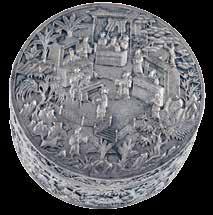
7.11 A silver gilt water-pot, the cylindrical body embossed with figures engaged in various pursuits, on horseback, fishing and carrying flags, in a forest setting on a deep blue enamel ground, the handle with an ivory fitting inlaid with a silver floral design, ‘Da Xing’ mark, 19th century. H: 17.5cm, L: 18.8 cm (Michael Backman Collection)
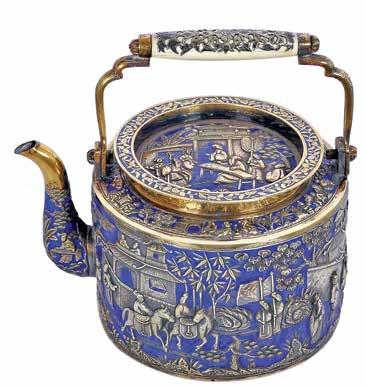
7.14 A blue and white “Jibo” tea set, comprising four lidded teacups and two larger lidded teacups on saucers all set on a matching round silver tray. Each item is decorated with the “Chor Bor Ror” cipher of King Rama V in the yi son design, late 19th century. D (tray): 26 cm, 906 g

7.14a Detail of the “Chor Bor Ror” insignia on the tray
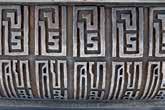

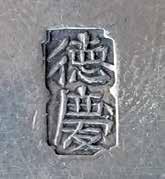
Pearce, (President of USA) Franklin 69
Penang 13, 48, 185, 186 peony motif 136 Peranakan 13 Persia and Persians 20, 25, 27, 44-46, 49, 57, 127
Petchaburi 209 Phattalung 58 phikul flower motif 136 Philadelphia Centennial Exposition 153 Phipek 43-44
Phonlathep, Chao Phraya 146 photograph frame 66 Phrae 33, 101-02
Phra Ram 141 Phutthai Sawan Throne Hall 179 Phuttan Throne 57, 58 picnic boxes 106
Pinto, Fernão Mendes 47 Plaek Phibunsongkhram 75 Pope Innocent XI 67 Portugal and Portuguese 19, 43, 44, 47, 160, Potosí silver mine 19 Prasart Museum 210 Prasart Vongsakul 210 Protestant Cemetery 155 Puk, Lady 77 purse 42, 50
rajasingh motif 141 Rama I, King 48 Rama II, King 21, 48, 185 Rama III, King 38, 128 Rama IV, King 68-69 Rama V, King 58, 68, 118, 150, 152, 153, 156-58, 175, 185, 195
Rama VI, King 161, 198 Rama VIII, King 71
Ramakien 26, 43, 57, 101, 112, 124, 127, 129, 138, 141, 181, 223
Ramayana 57, 127, 141, 223 Ratchaburi 209
Ratchawadi enamel 29
Rattanakosin 34, 184 Period (see also Bangkok period) 13, 51, 127, 150, 184, 186 Era dates 184 reliquaries 107
rice ball motif 142 Rome 43 rose motif 136-37 Rosenborg Castle 157 royal gifts 66-69, 152-53, 160
Royal Laws 44 Royal Military Academy, see Chulachomklao Military Academy
Royal Thai General System of Transcription (RTGS) 15
Ruan Ton 152 Russia and Russian 43, 48-49
Sal tree 179 Saovabha Phongsri, Queen 53, 143, 156, 159, 16263, 207 Cover of funeral album 143, 156 Sayburi 58 scissors 27 serving spoons 125 Second World War 41, 70 Shanghai 24, 187 ‘Shanghai silver’ 24, 187 shou motif 132-33 Siamese National Exhibition (1882) 147
Siam Society 47 Siam Sterling, see marks Siem Reap 23 Silver Techniques – Chasing 25 Damascene 27-28
Embossing 25 Enamelling 28 29 Engraving 30 Filigree 25, 30
Gilding 30 Inlay 27-28
Nielloware, see nielloware Openwork 32-33
Repoussé 32 Singapore 13, 193, 197 singh 46, 57, 130, 139 (see also lion)
Sirirat Kukkutthapan, Prince 162-63 Funeral pyre 164
Sirikit, HM Queen 41, 71, 155
Skilling, Peter 168, 171 Smith, Malcolm 159 Smithsonian Institution
68-69, 210 snuff taking 110-111, 159 snuff bottles 65, 111-113, 157 60, 173, 202 snuffboxes 65, 110, 113 14, 153
Sommatiwongse Varodaya, HRH Prince 160 Songkhla 58 Spanish real/dollar 19-20 spectacle cases 67 spittoons 38, 50, 62, 92 93, 99 squirrel motif 142 Sri Lanka 167 Straits Chinese Silver 13, 185-86 Suan Pakkad Palace 210 Sukhothai 15, 171 Suksan Chokrak 72 Sunanda Kumariratana, Queen 34, 99, 193, 202 sunflower pattern 136-37 SUPPORT Foundation 41, 71 Surat Thani 45 Surawong Wattanasak, Chao Phraya 160
Takua Pa 58 takrut 175 Tan Yue He (see Marks) teapots 118, see also Yixing teapots teapot warmer 121 tea sets 116 17, 121, 195, 201
Ten Crafts, The Department of the 150-51 Terwiel, Barend 179 Thai-Chinese 11, 14, 81, 84, 110, 117, 187, 189, 214 Thai Nakon 71 Thai Niello & Silver Ware Association 21 theppanom motif 54, 57, 100, 105, 109, 111, 122, 12324, 127, 143, 156
Third Reign 183 Thompat, see nielloware Thong Seur (see Marks) Toola ware 49 Trang 58 trays 58, 116 17, 120 23, 125, 132
trellis motif 143
Triphetchrut Dhamrong, Prince 162
Funeral pyre 164
USA 68
Van Beek, Steve 169 Versailles 67 Victoria & Albert Museum 210
Vietnam 19, 48, 191, 215
Vimanmek Palace 145, 152 Von Ferscht, Adrien 185 Vishnu 138
walking sticks 97 Warren, James 38 washing basins 108-09 Wat Benchamophit 181 Wat Mongkut Kasatriyaram 181
Wat Phra Mahathat, Nakhon Sri Thammarat 181
Wat Ratchaburana 34, 172 Wat Sri Suphan 166, 168, water bottle (khon tho) 59, 63, 107-09, 186 water jar 29 water lettuce leaf motif 136-37 water-pot 28, 36, 52, 64, 118, 119-20, 164, 187, 194, 196, 198, 203 04
Wieng Chan 19 Wright and Breakspear 154 Wualai Street 40
Würtembergische Metallwarenfabrik (WMF) 205-06
yak/yaksha (demons) 100, 111, 143, 156 Yaowarat 23 Yixing teapots 116 17, 118, 191, 201
Yongyuth Buakaew 72 Young, Ernest 77 Yugala Dighambara, HRH Prince 160
Zodiac designs Chinese 87, 127, 129 Thai 58, 72, 130